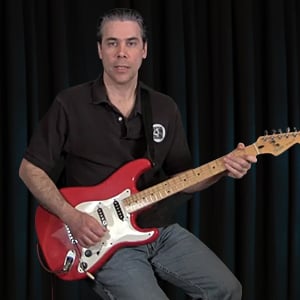- Intro
- Box 1 Pattern & Picking
- Box 1 Exercise 80BPM
- Box 1 Exercise 120BPM
- Box 2 Pattern & Picking
- Box 2 Exercise 80BPM
- Box 2 Exercise 120BPM
- Box 3 Pattern & Picking
- Box 3 Exercise 80BPM
- Box 3 Exercise 120BPM
- Box 4 Pattern & Picking
- Box 4 Exercise 80BPM
- Box 4 Exercise 120BPM
- Box 5 Pattern & Picking
- Box 5 Exercise 80BPM
- Box 5 Exercise 120BPM
- Box 1 Octave Higher Pattern & Picking
- Box 1 Octave Higher Exercise 80BPM
- Box 1 Octave Higher Exercise 120BPM
- Pentatonic Major Box Exercise Conclusion
Intro
In this tutorial we will learn & practice the five patterns of the major pentatonic scale. We guitarists often call these the pentatonic boxes. That's because the patterns form two "walls" and along with the top & bottom of the fretboard we've got a visual box. For these example exercises we will use the A major pentatonic scale.
Pentatonic major has 5 five notes (hence the name; "penta" means "five"). You start with the diatonic major scale which has 7 notes and leave 2 of them out.
So, we start with the A diatonic major notes and scale degrees:
A(1) - B(2) - C#(3) - D(4) - E(5) - F#(6) - G#(7)
Then, we leave out two notes, in pentatonic major the 4 & 7:
A(1) - B(2) - C#(3) - E(5) - F#(6)
Putting this on the fretboard get us a basic pattern/shape to use. Next, we move up the fretboard and find the same notes on different strings. This will create the 2nd "box" shape which "connects" to the previous pattern. We can do this all the way up the fretboard! The result is 5 interconnected boxes. This is because the pentatonic scale has 5 notes & we'll essentially give each note a chance to "start" it's own box.
If you are not familiar with this idea and these boxes, you should work though this previous tutorial on the pentatonic boxes.
Pentatonic Scales: Boxes & Frameworks
After you work through that you'll be ready to work though the exercises in this tutorial!

- Styles:
- Any Style
- Difficulty:
-
